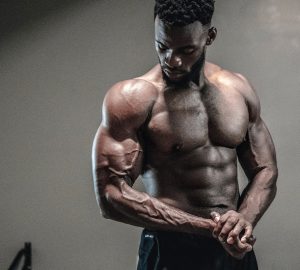Whatever the reason – a holiday, a budget that doesn’t allow for a gym membership, a zombie outbreak – what you want to know is simple: how to build muscle from home?
Real talk: it is harder, but not impossible. While your routine and the pace of your results may be slower than if you had full equipment access, you can still effectively build and maintain muscle without a fully stocked gym.
We’re here to give you the 101 on using what you’ve got (or haven’t got) to get ripped at home.
MUSCLE-BUILDING BASICS
Before we get into the specifics of building muscle at home, we need to go over some of the basic science behind gaining muscle.
During exercise, your muscles endure microscopic damage. When you rest up after your session, your body starts to repair the damaged tissue by fusing the damaged muscle fibers together. The result? Stronger, thicker, and more plentiful muscle fibers – AKA hypertrophy (a fancy word for muscle growth).
The thing is, your body adapts to exercise quickly, which is why progressive overload is essential for making continuous gains.
And what is progressive overload? Simply put, progressive overload is upping the intensity of your training so that your body is forced to adapt and get stronger.
The most common way to achieve progressive overload in strength training is to increase the weight you lift. But if you’re limited by a lack of equipment, there are other ways to challenge your muscles to spur further growth.
HOW TO BUILD MUSCLE AT HOME WITH BODYWEIGHT EXERCISES
Building muscle with bodyweight exercises (AKA calisthenics) – is it possible? The answer is yes, but you’ll need to be very dedicated and a little creative to achieve progressive overload.
The biggest obstacle when using only bodyweight to train for muscle growth is that it’s simply not as efficient as lifting heavy stuff. But that doesn’t mean it’s impossible.
Before we dive into the intricacies of gaining muscle with bodyweight training, here’s a reminder that you may have equipment without realizing it. A sack of potatoes, a family-sized bottle of laundry liquid, a backpack filled with books – you get the idea. You may have to go through a bit of trial and error to find the right substitute or anchor point and so on, but that can be part of the fun!
But hey, not everyone wants to swing a sack of potatoes around their living room in lieu of a kettlebell. So here are some tips for making your bodyweight workouts hard enough to induce muscle growth.
1. Increase your reps
This one is fairly straightforward. Simply complete more repetitions of each of the exercises in your bodyweight routine.
There is, however, a limit to the number of reps you should perform when your aim is to build muscle (as opposed to increasing endurance or generally improving fitness). While there is a lot of debate around exactly what that ideal rep range is for hypertrophy, it lies somewhere between 4 and 40 reps.
We recommend that once you hit the point where you can perform 20 reps of a bodyweight exercise, add holds, supersets or move on to an advanced version of that exercise.
2. Hold the pose for longer
Don’t want to play around with tonnes of fancy variations? A simple hold could be the key to keeping body-weight exercises challenging.
Adding holds to your bodyweight moves is a great way to tackle progressive overload.
Try this: perform your standard amount of reps, but add a hold to each one. You’ll be feeling the burn in no time.
3. Introduce supersets
What’s a superset? Performing two exercises back-to-back with no rest in between. So instead of taking a break to catch your breath and sip some water in between your jump squats and plank hold, you move straight from the air to the floor.
When it comes to achieving progressive overload with bodyweight-only exercise, supersets are helpful because they fatigue your body quicker. This means you’ll have to push harder to complete your routine.
4. Utilize variation
Depending on where you’re at in your fitness journey, you may find that repping out the standard version of bodyweight exercises – think a squat or lunge – is enough to wear you out.
But if muscle building is your goal (and if you’re reading this, it probably is) then you’ll need to add some variation to these bodyweight exercises eventually to achieve the necessary progressive overload.
Let’s use the not-so-humble push-up as an example. If you can perform three sets of 20 push-ups with great form, it’s time to introduce some variation to keep your muscles growing.
Switching to decline push-ups is an easy way to increase the resistance and up the intensity of this classic move.
You can also take your bodyweight workouts to the next level with some plyometric variations on the classics. Plyometric training uses explosive force or jumping to increase the intensity of an exercise. Need to perform 50 bodyweight squats to feel a burn? Turn those babies into jump squats and you’ll feel yourself fatigue much faster.
You get the idea. For every bodyweight exercise out there, variations exist that will challenge you. The only limits are time and your imagination.
There’s no getting around the fact that building muscle at home without equipment is simply not as efficient as doing so with equipment.
Is it possible? Absolutely! If you’re a beginner or an intermediate lifter, you can make good progress using no equipment. But it is likely that you’ll eventually hit a mass-stacking plateau, or run out of efficient ways to use your bodyweight to build muscle. At that point, you may find it beneficial to invest in a set of heavy dumbbells or a resistance band to continue smashing your home workouts. Speaking of resistance bands…
HOW TO BUILD MUSCLE AT HOME WITH RESISTANCE BANDS
How do you pull off an effective muscle-building workout without an expensive home gym setup? Two words: resistance bands.
Resistance bands are a great alternative strength training tool because they’re easy to use. Like cable machines, they allow you to isolate muscles. Like free weights, you can vary the resistance you’re pushing. But unlike weights and cables, bands are a cheap, portable item you can throw into a bag and literally get your workout done anytime, anywhere.
The benefits of resistance bands
They may look no match for barbells, but resistance bands have a cool muscle-building trick up their sleeve. When performing an exercise, bands place constant tension on your muscles through the full range of motion – from top to bottom on every move. This triggers more muscle activation and creates the micro-tears you need to repair and build muscle.
How to choose the right resistance band
You want to pick a band that challenges you in the rep range you’re working in, but still allows you to perform the exercise with control and good form. So what do you look for when buying bands?
- Short length (or small loop) bands are designed to wear above the knees to work your hips, glutes, and hamstrings.
- Long length bands are better suited to full-body exercises, and for assists (on pull-ups, etc.)
- You’ll usually find the thicker the band, the stronger it is and the more resistance it will provide. Bands are often color-coded, with lighter colors (e.g. yellow) offering light resistance and darker colors (e.g. black) the most resistance. However, these colors can depend on the brand, so read the description before buying.
- It’s good to have a variety of bands to use for different exercises and to keep challenging yourself as you get stronger.
Note: Wide, flat strips known as therapy bands are better used for stretching, recovery, and rehabilitation than for strength training.
How to use resistance bands
These quick tips will help you get more from every session.
- Slow down the lowering (eccentric) movement to maximize muscle tears and boost growth. When doing banded bicep curls, for instance, lifting the band to your shoulders should take 1 second, and lowering it back down 3 seconds. This is the sweet spot for getting gains!
- Limited on bands? If you’re finding an exercise too easy, stretching the band further will create a greater resistance without needing to find a thicker band.
- When anchoring your band to a stationary object, make sure that the object is solid, stable, and won’t move when you pull on the band – like a heavy sofa leg or fixed metal bar. The less furniture flying around your place, the better.
3 resistance band exercises to build muscle
Bent over rows
This exercise builds strength and definition in your mid and upper back and works your shoulders and arms while you’re at it.
Anchored V-sits
V-sits target your abdominal muscles from multiple angles to build core strength. By adding resistance, you’re forcing your abs to work harder for an even bigger burn.
Banded deadlift
This staple move amps up lower-body and lifting power by working your glutes, hamstrings, hip flexors, and lower back.
HOW TO BUILD MUSCLE AT HOME WITH DUMBBELLS
If you’ve got a decent set of dumbbells at home, you can perform variations of pretty much all the major compound and isolated lifts, as well as plenty of machine exercises. Try these alternatives on for size:
Dumbbell modifications for fly exercises
Stick with dumbbell flys – and use a chair, cushions, or Swiss ball to replicate incline or seated positions. You can also loop two light resistance bands around a post or solid sofa leg and (with your back to the post) walk forward until you have the right resistance to perform a band fly.
Dumbbell modifications for curling exercises
Keep curling with dumbbells and mix it up between hammer, Zottman, bench curls, and so on. If you don’t have dumbbells, loop light/medium bands around your feet, and holding the bands in your hands, curl upwards against the resistance.
Dumbbell modifications for pulling exercises
Grab your dumbbells to perform overhead raises, bent-over rows, renegade rows or front raises, and overhead tricep extensions.
Dumbbell modifications for pressing exercises
For presses using your arms that work your chest, back, and shoulders, switch to dumbbell flys, floor presses, or overhead raises.
Whether you’re typing to stack on muscle using bodyweight, free weights of barbells and machines, training is just part of the story.









